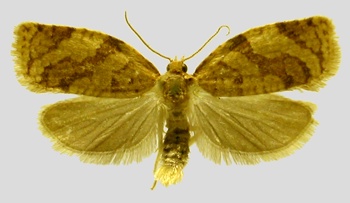Pests
Adoxophyes orana (F.R.) - Summer Fruit Tortrix Moth.
Taxonomic position.
Class Insecta, order Lepidoptera, family Tortricidae, subfamily Tortricinae, tribe Archipini, genus Adoxophyes.Synonyms.
Capua reticulana Hbn., Cacoecia reticulana Hbn.Biological group.
Pests of fruit and berry crops.Morphology and biology.
Wings ocher-yellow or light-brown, with a pattern of transverse and longitudinal lines; male wing with costal outfold (wingspan 15-22 mm).Female wing, less distinct; male wing has 3 highly visible main spots: a pretornal spot, median band, and subapical spot. Hind wings brownish-gray, with lighter anterior margin. Eggs flat, discoid, light yellow or yellow-green. Younger caterpillars yellow-green. Head and prothoracic scutellum black. Adult caterpillars olive green or dark green. Head, prothoracic scutellum and thoracic legs light or yellow brown. Cremaster appears as a strong blade bent ventrad, with 8 hooked setae. Four setae are located crosswise at apex and two are lateral. Pupa are 8-13 mm in length, narrow, lengthened, brown with green tint, with darker dorsum; stigmas oval. Winter diapausing caterpillars of 2nd-4th (more often 3rd) instars winter in white cocoons under bud scales in forks of branches, less often in cracks of bark of arboreal plants, sometimes with fruits in storehouses. In spring they damage blossoming buds, especially at tops of shoots. Then they damage leaves by rolling in hoods, tubes, or bunches, strapped in silk thread. Summer caterpillars cause more harm, plaiting leaves to ovaries and fruits, gnawing them round. Pupation occurs in loose cocoons in places of feeding, in vegetation residues, and in cracks of bark. Development of pupa lasts 10-12 days. Female lays eggs in groups mainly on smooth top surface of apple leaves, but on both sides of pear leaves during the 1st generation; also on shoots, ovaries, and fruits during the 2nd generation of the pest. Shield-like egg-batches (80-100 eggs on average) look like yellow-green, varnished, indistinct drops 2-6 mm in diameter. In the Ukraine embryonal development lasts 8-14 days during the 1st generation, 11 days on the average during the 2nd one. Autumn caterpillars skeletonize the lower side of leaves, eating away their pulp; only veins remain untouched.Distribution.
Europe (everywhere), Korea, Northern Vietnam, mountains of India and Myanmar, China, Japan. In the former USSR it is distributed in the European part (everywhere, except for the north), in Transcaucasia, Volga Basin region, Cis-Ural region, North Kasakhstan, southern Siberia; in the Far East, i.e., in Khabarovsk and Primorskii Territories, Amur and Sakhalin Regions, Southern Kurils (Kunashir I.).Ecology.
Monovoltine in northwestern Russia, bivoltine in Middle Europe. In spring caterpillars return to feeding during the blossoming of apple buds (normally from the end of April) at temperature 9°C. Optimum temperature for moth flight is near 18°C; moth activity ceases at temperatures 12-14°C and lower. In Transcarpathia moths of the 1st generation fly from the 2nd half of May until the end of June, peaking in the beginning of June, and imagoes of the 2nd generation fly from the end of July until the end of September, peaking in mid-August. Thus it is possible to find all developmental stages of the insect from June until August. Oviposition is possible within temperature ranges of 15-32°C. The lowered humidity and high air temperature in the summer sharply reduce female fertility. Development of all stages is only possible with air humidity of 60% and higher and within temperature ranges of 10-30°C. Hatching caterpillars migrate passively with the help of the wind, hanging on silk threads. In September-October they start to diapause.Economic significance.
The species is a dangerous pest to all deciduous trees and bushes, especially on flood-lands and in humid areas. Polyphagous caterpillars damage apple, pear, rose, plum, cherry, apricot, sweet cherry, currant, gooseberry, hazel, Schizandra, pistachio, hop, birch, beech, alder, willow, poplar, maple and more. They can also develop on grassy plants including weeds (pigweed, wormwood). Damaged fruits are deformed, rotting as a result of infection with moniliosis; rating is sharply reduced and fruits drop. Caterpillars of the 2nd generation are more noxious than those of the 1st one. Control measures: agronomic measures include pruning old and diseased branches; biological measures include the application of biological preparations. Chemical measures include local insecticide treatments during the appearance of over-wintered caterpillars before flowering and in summer. Monitoring and forecasting are possible with the use of pheromone traps and meteorological predictors.Reference citations:
Ermolaev V.P. 1988. Tortricidae. In: Kirpichnikova V.A., Ler P.A., eds. Butterflies - pests of agriculture in the Far East. Keys. Vladivostok: Biology and Soil Institute, DO AN SSSR: 65-99. (in Russian).Galetenko S.M. 1964. To morphology of fruit leafrollers In: Kochkin M.A., Rubtsov N.I. & Ryndin N.V., eds. 150 years to State Nikitskii botanical garden. Collection of scientific works. V. 37. Moscow: Kolos, p. 531-395. (in Russian).
Kostyuk Yu.A. 1974. Family Tortricidae. In: Vasil.ev, V.P., ed. Pests of agricultural crops and forest plantations. V.2. Arthropods. Kiev: Urozhai, p. 261-320 (in Russian).
Kuznetsov V.I. 1994. Family Tortricidae. In: Kuznetsov, V.I., ed. Insects and mites - pests of agricultural plants. V. 3(1).Lepidoptera. St.Petersburg: Nauka, p. 51-234 (in Russian).
Savkovskii P.P. 1976. Atlas of the pests of fruit and berry plants. Kiev: Urozhai. 207 p. (in Russian).
Vasil.ev V.P., Livshits I.Z. 1984. Pests of fruit crops. Moscow: Kolos, 399 p. (in Russian)..


